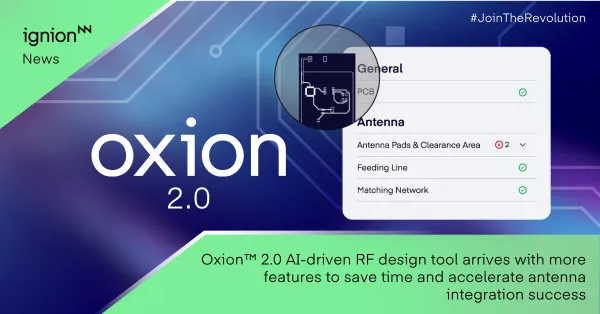Products
Applications
Solutions
Register your interest
In the Ignion’s Oxion Platform
Ignion‘s Oxion Platform is changing the way engineers approach wireless design. With virtual antenna technology and AI-driven tools, Ignion has eliminated the complexity of RF integration for IoT developers. Whether you’re working on Bluetooth sensors, Wi-Fi-enabled smart devices, or cellular edge nodes, Oxion removes the guesswork from antenna selection and layout.
At the heart of Ignion’s Oxion Platform is a suite of seven modular virtual antennas. These cover a massive 400 MHz to 10 GHz range, replacing the thousands of custom RF designs engineers used to wrestle with. This means fewer product variants, lower cost, and dramatically shortened development cycles. Each module is designed to be highly tunable, compact, and platform-agnostic—ready to work with nearly any wireless protocol or chip vendor.
But hardware is only half the story. The Oxion software platform leverages machine learning and Ignion’s vast dataset of anonymised real-world designs to provide tailored RF recommendations based on your PCB layout, regional certifications, and desired wireless performance. Ignion’s Oxion Platform lets you drop in your specs and receive DXF layout files, simulation-level predictions, and even instant design validation.
And the real innovation? Real-time design feedback. Oxion allows you to see in seconds how changes to your board—such as antenna placement or ground plane size—will impact your final wireless performance. This lets you design your RF subsystem in parallel with your main application logic, not as a costly afterthought.
For engineers under pressure to meet deadlines and deliver reliable connectivity, Ignion’s Oxion Platform enables a faster, more predictable development process. It’s especially valuable for teams without in-house RF specialists, giving them the power to build high-performance wireless products without needing deep antenna expertise.
And if your design still runs into trouble, Oxion includes the option to escalate to Ignion’s in-house engineers for a manual review—combining the speed of automation with the assurance of expert insight.
With Oxion, virtual antenna design becomes a strategic advantage, helping engineers build smarter, smaller, and more reliable connected devices. Whether you’re building IoT at scale or just starting a prototype, this is RF done right.
Register your interest
In the Ignion’s Oxion Platform
